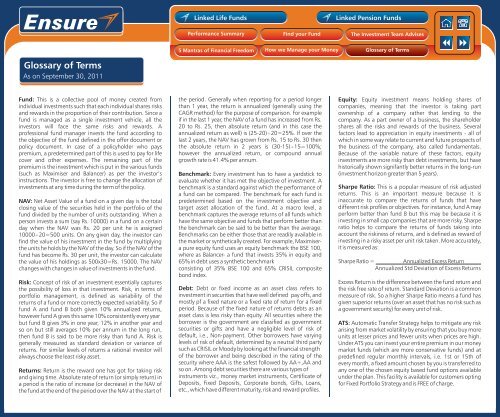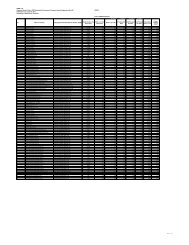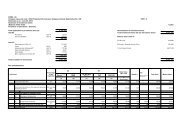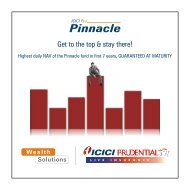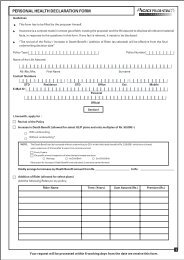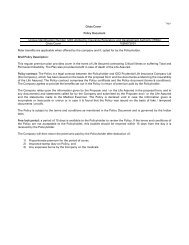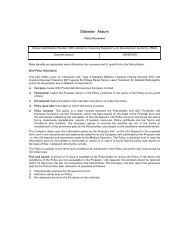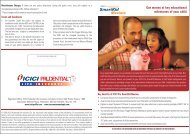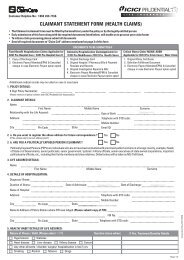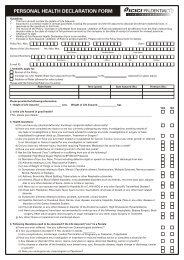Ensure Brochure Oct 2011
Ensure Brochure Oct 2011
Ensure Brochure Oct 2011
Create successful ePaper yourself
Turn your PDF publications into a flip-book with our unique Google optimized e-Paper software.
Glossary of Terms<br />
As on September 30, <strong>2011</strong><br />
Fund: This is a collective pool of money created from<br />
individual investments such that each individual shares risks<br />
and rewards in the proportion of their contribution. Since a<br />
fund is managed as a single investment vehicle, all the<br />
investors will face the same risks and rewards. A<br />
professional fund manager invests the fund according to<br />
the objective of the fund defined in the offer document or<br />
policy document. In case of a policyholder who pays<br />
premium, a predetermined part of this is used to pay for life<br />
cover and other expenses. The remaining part of the<br />
premium is the investment which is put in the various funds<br />
(such as Maximiser and Balancer) as per the investor’s<br />
instructions. The investor is free to change the allocation of<br />
investments at any time during the term of the policy.<br />
NAV: Net Asset Value of a fund on a given day is the total<br />
closing value of the securities held in the portfolio of the<br />
fund divided by the number of units outstanding. When a<br />
person invests a sum (say Rs. 10000) in a fund on a certain<br />
day when the NAV was Rs. 20 per unit he is assigned<br />
10000÷20=500 units. On any given day, the investor can<br />
find the value of his investment in the fund by multiplying<br />
the units he holds by the NAV of the day. So if the NAV of the<br />
fund has become Rs. 30 per unit, the investor can calculate<br />
the value of his holdings as 500x30=Rs. 15000. The NAV<br />
changes with changes in value of investments in the fund.<br />
Risk: Concept of risk of an investment essentially captures<br />
the possibility of loss in that investment. Risk, in terms of<br />
portfolio management, is defined as variability of the<br />
returns of a fund or more correctly expected variability. So if<br />
fund A and fund B both given 10% annualized returns,<br />
however fund A gives this same 10% consistently every year<br />
but fund B gives 3% in one year, 12% in another year and<br />
so on but still averages 10% per annum in the long run,<br />
then fund B is said to be more risky than fund A. Risk is<br />
generally measured as standard deviation or variance of<br />
returns. For similar levels of returns a rational investor will<br />
always choose the least risky asset.<br />
Returns: Return is the reward one has got for taking risk<br />
and giving time. Absolute rate of return (or simply return) in<br />
a period is the ratio of increase (or decrease) in the NAV of<br />
the fund at the end of the period over the NAV at the start of<br />
Linked Life Funds<br />
Performance Summary<br />
5 Mantras of Financial Freedom<br />
Find your Fund<br />
How we Manage your Money<br />
the period. Generally when reporting for a period longer<br />
than 1 year, the return is annualized (generally using the<br />
CAGR method) for the purpose of comparison. For example<br />
if in the last 1 year, the NAV of a fund has increased from Rs.<br />
20 to Rs. 25, then absolute return (and in this case the<br />
annualized return as well) is (25-20)÷20=25%. If over the<br />
last 2 years, the NAV has grown from Rs. 15 to Rs. 30 then<br />
the absolute return in 2 years is (30-15)÷15=100%;<br />
however the annualized return, or compound annual<br />
growth rate is 41.4% per annum.<br />
Benchmark: Every investment has to have a yardstick to<br />
evaluate whether it has met the objective of investment. A<br />
benchmark is a standard against which the performance of<br />
a fund can be compared. The benchmark for each fund is<br />
predetermined based on the investment objective and<br />
target asset allocation of the fund. At a macro level, a<br />
benchmark captures the average returns of all funds which<br />
have the same objective and funds that perform better than<br />
the benchmark can be said to be better than the average.<br />
Benchmarks can be either those that are readily available in<br />
the market or synthetically created. For example, Maximiser-<br />
a pure equity fund uses an equity benchmark the BSE 100,<br />
where as Balancer- a fund that invests 35% in equity and<br />
65% in debt uses a synthetic benchmark<br />
consisting of 35% BSE 100 and 65% CRISIL composite<br />
bond index.<br />
Debt: Debt or fixed income as an asset class refers to<br />
investment in securities that have well defined pay offs, and<br />
mostly pf a fixed nature or a fixed rate of return for a fixed<br />
period. Because of the fixed nature of returns debts as an<br />
asset class is less risky than equity. All securities where the<br />
borrower is the government are classified as government<br />
securities or gifts and have a negligible level of risk of<br />
default, i.e., Non-payment. Other borrowers have varying<br />
levels of risk of default, determined by a neutral third party<br />
such as CRISIL or Moody by looking at the financial strength<br />
of the borrower and being described in the rating of the<br />
security where AAA is the safest followed by AA+,AA and<br />
so on. Among debt securities there are various types of<br />
instruments viz., money market instruments, Certificate of<br />
Deposits, Fixed Deposits, Corporate bonds, Gifts, Loans,<br />
etc., which have different maturity, risk and reward profiles.<br />
Linked Pension Funds<br />
The Investment Team Advises<br />
Glossary of Terms<br />
Equity: Equity investment means holding shares of<br />
companies, meaning that the investor is taking part<br />
ownership of a company rather that lending to the<br />
company. As a part owner of a business, the shareholder<br />
shares all the risks and rewards of the business. Several<br />
factors lead to appreciation in equity investments - all of<br />
which in some way relate to current and future prospects of<br />
the business of the company, also called fundamentals.<br />
Because of the variable nature of these factors, equity<br />
investments are more risky than debt investments, but have<br />
historically shown signifantly better returns in the long-run<br />
(investment horizon greater than 5 years).<br />
Sharpe Ratio: This is a popular measure of risk adjusted<br />
returns. This is an important measure because it is<br />
inaccurate to compare the returns of funds that have<br />
different risk profiles or objectives. For instance, fund A may<br />
perform better than fund B but this may be because it is<br />
investing in small cap companies that are more risky. Sharpe<br />
ratio helps to compare the returns of funds taking into<br />
account the riskiness of returns, and is defined as reward of<br />
investing in a risky asset per unit risk taken. More accurately,<br />
it is measured as:<br />
Sharpe Ratio = Annualized Excess Return<br />
Annualized Std Deviation of Excess Returns<br />
Excess Return is the difference between the fund return and<br />
the risk free rate of return. Standard Deviation is a common<br />
measure of risk. So a higher Sharpe Ratio means a fund has<br />
given superior returns (over an asset that has no risk such as<br />
a government security) for every unit of risk.<br />
ATS: Automatic Transfer Strategy helps to mitigate any risk<br />
arising from market volatility by ensuring that you buy more<br />
units at lesser prices and fewer units when prices are high.<br />
Under ATS you can invest your entire premium in our money<br />
market funds (which are more conservative funds) and at<br />
predefined regular monthly intervals, i.e. 1st or 15th of<br />
every month, a fixed amount chosen by you is transferred to<br />
any one of the chosen equity based fund options available<br />
under the plan. This facility is available for customers opting<br />
for Fixed Portfolio Strategy and is FREE of charge.


